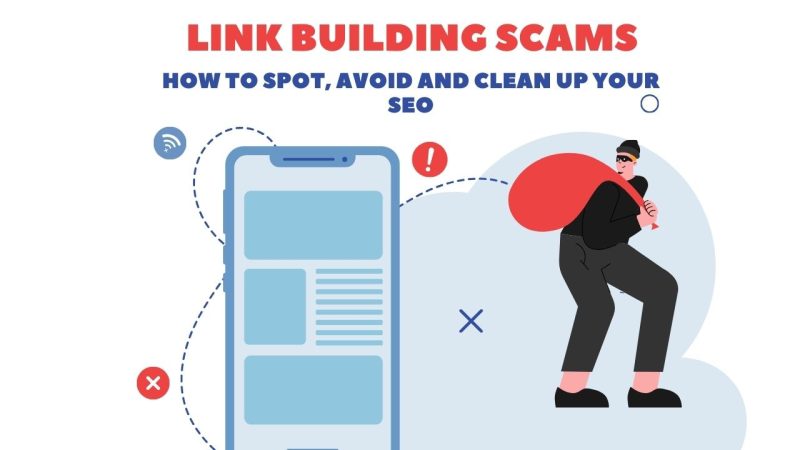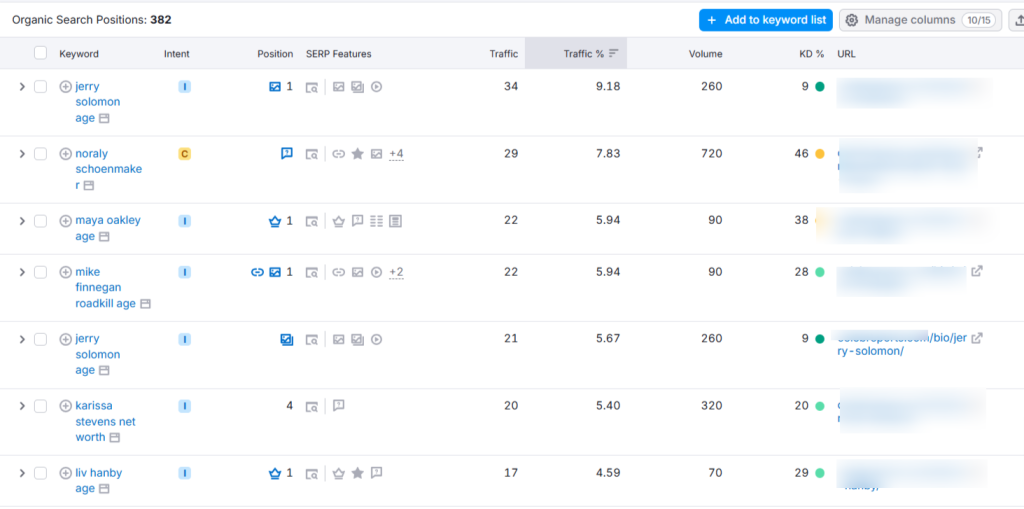
Link Building Scams: How to Spot, Avoid and Clean Up Your SEO
Adam White
Posted on February 10, 2025
Link building is brutal. It’s super expensive, time-consuming and an uphill battle even for the best SEOs. Yet, businesses often resist this reality. After all, it’s just a backlink, right?
A survey by Authority Hacker found that 52.3% of digital marketers consider link building the toughest part of SEO. Even more telling, 60% prefer outsourcing it, because doing it right is a grind.
Links are also a major ranking factor, therefore the demand has always been high and will be. Businesses and SEOs are in the race of building more links than their competitors irrespective of the quality and actual impact they can make on their website.
If you’re an SEO, a digital marketer, or a business pouring money into link building, it’s time to ask yourself: Is your investment actually paying off, or are you just getting played?
The truth is, bad link-building schemes don’t just exhaust your budget but also hazard your rankings or even get you penalized.
In this guide, we’re exposing link-building scams you might not even realize are scams. Some look natural, some seem harmless, but all of them can quietly kill your SEO.
Stick around, and by the end, you’ll know how to avoid these traps but also how to clean up any mess if you’ve already fallen for one.
1. Private Blog Networks (PBNs)
A Private Blog Network (PBN) is a collection of websites created solely to manipulate search engine rankings by interlinking among themselves. These networks often use expired domains that previously held authority.
At first glance, these sites might seem legitimate. Some even have some traffic, but don’t be fooled, search engines no longer favor them. The traffic they receive is from the super-easy-to-rank keywords that hold little real value for your website niche. Check out the screenshot, you will understand.

Anyone can throw together a few backlinks, rank for low-competition keywords, and then sell guest posts for $50-$100. That doesn’t mean these links will help your rankings. It means you’re being sold junk.
Why It’s Harmful
- Google Detects and Deindexes PBNs
Google actively hunts down and penalizes PBNs. When detected, not only are the PBN sites removed from search results but the primary site benefiting from these links can also face severe penalties such as massive ranking drops or complete deindexing. - Lack of Genuine Content and Traffic
PBN sites usually don’t have real content and real user engagement. The articles are generic, spammy, or irrelevant. Most of these sites rank for useless keywords just to appear credible. But in reality they offer no real value to users.
How to Spot & Avoid PBNs
- Check the Content and Engagement: Look for poorly written, irrelevant, or overly generic articles. And, check if the website has actual engagement in forms of comments, shares, or real discussions. Most PBNs don’t have it because they don’t have to offer anything informative and new.
- Watch for Artificial Interlinking: If a website excessively links to a specific group of websites without clear relevance, it’s a red flag. PBNs create unnatural link structures. There are many websites linking to each other which are designed to boost rankings but are easy to spot with manual review.
- Be Skeptical of “High DA” Link Offers: If someone guarantees a large number of high DA links quickly, Run. Because quality link building is a long-term process and real, authoritative sites don’t sell links in bulk, they have a strict review process for each article that is published on their website and it takes time and not all get approved.
- A Super Easy Way to Spot a PBN: If some sent you a sheet, and you’re still unsure, check the Contact Us page of a few websites. If you find multiple sites using the exact same email address, you’ve just uncovered a PBN. Don’t get tricked by traffic numbers, DR, or DA—if it’s a PBN, the link is worthless.
Avoiding PBNs is crucial if you care about long-term SEO success. A few risky links might seem harmless at first but once Google catches on, the damage can be devastating.
2. Link Farms
Link farms are websites created solely for making money through guest posts and link insertions. They look like normal websites, but their only purpose is selling backlinks. Unlike PBNs, which interlink within a controlled network, link farms don’t necessarily give backlinks to each other. These sites can be broad or niche-focused but the goal remains the same: sell links, not provide useful information.
Why It’s Harmful
1. Garbage Content That Adds No Value
These sites are created with zero passion, zero expertise, and zero real purpose other than selling links. The content is often generic, uninspired, and stuffed with unnatural paid links. Readers gain nothing from it and search engines don’t value it either.
2. A Fake Backlink Profile
At first glance, these sites often show high DA (Domain Authority) and DR (Domain Rating) that makes them seem credible. But dig deeper, and you’ll notice odd stuffs:
- They didn’t build this authority through earned backlinks.
- Instead, they increased their DA/DR with spammy redirects and manipulative tactics.
- This can make your backlink profile look unnatural and lead to penalties in the long run.
3. Overpriced and Not Worth It
Since link farms exist only to sell links, their owners ask for aggressively high prices for links and guest post placement—often charging hundreds of dollars for a single guest post. And the worst part? These links don’t move the needle for rankings. And overtime search engines identify them which makes your investment a complete waste.
How to Spot & Avoid Link Farms
1. Keyword and Internal Linking Patterns
Take a look at a few posts—do they all have 2-3 links pointing to the same sites? Are those external links stuffed unnaturally into the content? If yes, red flag. This is a clear sign that the site is a link farm and Google can detect this very easily.
2. Check the Backlink Profile
For checking the backlink profile you can use Serpple Backlink Monitoring Tool. If you notice a ton of redirects, spammy links, or irrelevant domains. This is not a sign of a legitimate website.
3. Content That Feels Off
Does the website have real content that’s written for readers, or does it sound robotic with general info? If the blog exists just to publish guest posts. It’s not the right place to get a link from.
3. 301 Redirect Schemes
Increase your DA or DR from 10 to 70 in just one month!” Sounds like a dream, right? The kind of “too good to be true” service that some shady SEO vendors push. But here’s the truth: real websites take years to build their authority. If someone promises you a massive Domain Rating (DR) boost in 30 days, without a doubt – it’s a SCAM!
These sellers won’t tell you they’re using 301 redirect schemes. Instead, they’ll just promise “high authority” improvements. And technically, your DA and DR will go up and you will see it in all SEO tools such Ahrefs and Moz. But for Google – It’s meaningless.
Why It’s Harmful
1. Google Ignores These Links
Redirect schemes don’t pass real SEO value. Google either neutralizes or completely ignores them. So while your DR might look impressive in Ahrefs, it won’t do anything for rankings. Zero impact.
2. A Complete Waste of Money
Investing in link farms are just for the metrics—not real authority. Since these links don’t actually help SEO, your site gains nothing. And worse, if Google ever decides to crack down, you could see negative effects.
How to Spot 301 Redirect Schemes
1. Look for Sudden DR/DA Surges
Use SEO tools to monitor backlinks. If you see a massive spike in backlinks followed by a sudden drop, that’s a huge red flag. Natural link growth happens gradually, not overnight.
2. Manually Check the Backlinks
In your SEO tool, check the referring domains. If most of them are labeled as “redirect” links, that’s the scam in action.
4. Automated Link Building with Bots
If there’s one surefire way to wreck your website’s SEO, it’s automated link-building bots. These bots can generate thousands of backlinks in minutes and flood your website’s backlink profile with spammy, low-quality links. Ofcourse, Google hates them.
This is not just a bad link building practice but the worst kind. Automated links are also used for negative SEO attacks to sabotage competitors. But some website owners actually do this to their own sites, thinking they’ve found a shortcut to better rankings. However, these tactics can backfire, leading to penalties instead of progress. The best way is to shift to hands-free link-building subscription. This is a safer, more effective way to build quality backlinks without resorting to spammy methods
A Real-Life SEO Horror Story
I once worked on an eCommerce clothing site that seemed to be doing well—until I dug into its backlink profile. Thousands of bot-generated links. At first, I assumed it was a negative SEO attack, but after digging deeper, I found out the business did this intentionally.
Big mistake.
The site held up for a while, but then came the July 2021 Link Spam Update (rolled out from July 26 to August 24, 2021). And just like that—boom—rankings vanished. Every keyword tanked.
After finding and disavowing those toxic links, it took months to clean up the mess. Moral of the story? Don’t do this to websites.
Why It’s a Disaster
1. The Fastest Way to Get Penalized
Google instantly detects these spammy, bot-created backlinks. The moment it spots them—penalty is coming. Have a look at how backlinks are placed. Awful!

2. Your Rankings Will Sink
Just because you see thousands of links doesn’t mean they’re helpful. In reality, they’ll bury your site in Google’s blacklist.
3. It’s a Pain to Fix
Disavowing thousands of toxic backlinks takes months because—if not longer. And until you clean up, your site’s rankings are in danger.
How to Avoid:
To avoid this, stay away from ultra-cheap link-building services that promise thousands of links overnight. If it sounds too good to be true, it is. Even if you don’t pay for these links, your competitors can. So check your backlink profile regularly using SEO tools like Serpple, Ahrefs, SEMrush. If you see the link profile like the one in the screenshot below it’s time to dig down and check the spammy links. Read further to find out how you can clean up your link profile. We have got you covered. Don’t worry!

5. Edu and .Gov Link Scams
.Edu and .Gov links are SEO gold but only when they’re earned. Universities and government websites carry massive authority and getting a legitimate backlink from them is precious and rare because they don’t sell links.
If someone’s offering you an Edu or Gov link for a few bucks, Run. Because those will not be real placements. They’re either hacked pages or abandoned accounts and Google is not fooled by them.
Why It’s Harmful
1. Google Detects and Nullify Them
Google has zero tolerance for hacked links. Even if these pages somehow get indexed, they’ll be wiped out fast—along with any SEO benefit. Worst-case scenario? Your site could be flagged for participating in black-hat SEO tactics.
2. These Links Rarely Help Rankings
Search engines know the difference between hacked and real and spammy placements won’t pass any real authority.
How to Spot & Avoid the Scam
1. Check Site History with Wayback Machine
Use Wayback Machine to see if the page existed before the backlink offer. If it suddenly appeared, it’s likely a hacked or spammed page.
2. Be Skeptical of “Cheap” Edu/Gov Links
Universities and government agencies don’t sell links, they naturally give links when content deserves it. If someone is offering easy access, they’re most probably hacked accounts or abusing loopholes.
How to Clean Up Bad Links and Recover SEO
If bad backlinks are dragging down your site’s rankings, take action. Ignoring toxic links won’t make them disappear—Google sees them, and if you don’t clean them up, your SEO will suffer. Follow these steps to identify, remove, and recover from harmful links.
A. Identify Toxic Backlinks
Start with a full backlink audit using tools Serpple Backlink Monitoring Tool. Spammy, irrelevant, or unnatural links (e.g., from low-quality blogs, foreign-language sites, or link farms). We know sorting through your backlinks manually can be time-consuming but it’s crucial to separate valuable links from toxic ones.
B. Remove Harmful Links Manually
Once you’ve identified bad links, follow these steps to get them removed from the source:
- Reach out to webmasters of the linking sites and request removal.
- Be polite, keep it short, and provide the exact URLs you want removed.
- If they refuse, ignore you, or demand payment—move on to the next step.
Not all webmasters will cooperate but attempting manual removal is still worth trying before disavowing links.
C. Disavow Bad Links
The last option: If you can’t get bad links removed manually, tell Google to ignore them using the Disavow Tool in Google Search Console.
Steps to disavow links:
- Create a .txt file listing the harmful domains or specific URLs.
- Format the file correctly (one link per line, using “domain:” for entire domains).
- Upload the file via the Google Disavow Tool in Search Console.

This signals to Google that these links are not created by you so don’t count it. It reduces the risk of penalties.
D. Strengthen Your SEO with Ethical Practices
Cleaning up bad links is just the first step. Now the heavy lifting starts, you need to make efforts to earn links that actually move the needle. Wanna know how? Check our guide on proven SEO link building Strategies and thank us later.
How to Choose a Trustworthy Link-Building Service
If you’re an SEO professional or a business too busy with other priorities to handle link building yourself, here’s what you need to keep in mind when choosing a link builder who delivers real value. They’re hard to find, but these steps will help you spot the right one.
What to Look For in a Link-Building Service
Transparency
A trustworthy link building agency will explain exactly how they build links, provide case studies, and offer sample links to review before you commit. If they dodge questions, they’re hiding something.
Quality Over Quantity
White hat link-building is not about how many links you get but the quality and relevance of the source. The best agencies and freelancers focus on securing relevant, high-authority backlinks from real and authoritative websites.
Relevance is Key
A relevant backlink from a smaller site in your industry is far more valuable than a random high-DA link from an unrelated niche. Plus, anchor text should also feel natural within the blog. Forced or unnatural links are a red flag.
Ethical, White-Hat SEO
A reliable agency follows Google’s guidelines, avoids shady tactics, and focuses on long-term SEO growth rather than quick fixes. So, choose accordingly.
Conclusion:
Link-building can boost your SEO—but only if done right. Scams like PBNs, link farms, and 301 redirect schemes can tank your rankings and even lead to penalties. Always invest in quality link-building services, avoid cheap shortcuts, and focus on earning natural, high-quality backlinks.
Regularly check your backlinks using the Serpple Backlink Monitoring Tool to spot and remove harmful links. Instead of chasing risky shortcuts, create valuable content that naturally attracts authoritative backlinks. SEO success comes from trustworthy practices, not tricks. Stay smart, stay ethical, and build links that actually help.
Published by
Adam White
Adam White is a 20+ year SEO professional who has optimized over 400 websites, built and sold over 20 internet and SaaS businesses all with SEO as the main traffic source. Follow him on Twitter/X
All stories by Adam White

